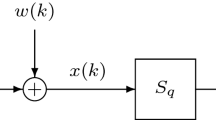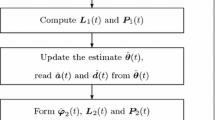Abstract
In this paper, a recursive least squares algorithm is proposed for a class of nonlinear dual-rate systems. By using the missing-output estimation model, the unavailable outputs can be estimated. Then, the unknown parameters can be estimated from all the inputs and outputs. Compared with the polynomial transformation technique and the lifting technique, the unknown parameters can be estimated directly by using the missing-output estimation model, without increasing the number of parameters. The convergence analysis and the simulation results indicate that the proposed method is effective.






Similar content being viewed by others
References
F.Y. Chen, F. Ding, J.H. Li, Maximum likelihood gradient-based iterative estimation algorithm for a class of input nonlinear controlled autoregressive ARMA systems. Nonlinear Dyn. 79(2), 927–936 (2015)
J. Chen, Several gradient parameter estimation algorithms for dual-rate sampled systems. J. Franklin Inst. 351(1), 543–554 (2014)
J. Chen, Y.X. Ni, Parameter identification methods for an additive nonlinear system. Circuits Syst. Signal Process. 33(10), 3053–3064 (2014)
F. Ding, T. Chen, Combined parameter and output estimation of dual-rate systems using an auxiliary model. Automatica 40(10), 1739–1748 (2004)
F. Ding, X.M. Liu, Y. Gu, An auxiliary model based least squares algorithm for a dual-rate state space system with time-delay using the data filtering. J. Franklin Inst. 353(2), 398–408 (2016)
F. Ding, X.M. Liu, M.M. Liu, The recursive least squares identification algorithm for a class of Wiener nonlinear systems. J. Franklin Inst. 353(7), 1518–1526 (2016)
F. Ding, X.M. Liu, X.Y. Ma, Kalman state filtering based least squares iterative parameter estimation for observer canonical state space systems using decomposition. J. Comput. Appl. Math. 301, 135–143 (2016)
F. Ding, X.P. Liu, H.Z. Yang, Parameter identification and intersample output estimation for dual-rate systems. IEEE Trans. Syst. Man Cybern. A Syst. Hum. 38(4), 966–975 (2008)
F. Ding, X.H. Wang, Q.J. Chen, Y.S. Xiao, Recursive least squares parameter estimation for a class of output nonlinear systems based on the model decomposition. Circuits Syst. Signal Process. (2016). doi:10.1007/s00034-015-0190-6
J. Ding, J.X. Lin, Modified subspace identification for periodically non-uniformly sampled systems by using the lifting technique. Circuits Syst. Signal Process. 33(5), 1439–1449 (2014)
G.C. Goodwin, K.S. Sin, Adaptive Filtering, Prediction and Control (Prentice-Hall, Englewood Cliff, 1984)
H. Li, Y. Shi, W. Yan, On neighbor information utilization in distributed receding horizon control for consensus-seeking. IEEE Trans. Cybern. (2016). doi:10.1109/TCYB.2015.2459719
H. Li, Y. Shi, W. Yan, Distributed receding horizon control of constrained nonlinear vehicle formations with guaranteed \(\gamma \)-gain stability. Automatica 68, 148–154 (2016)
H. Li, P. Xie, W. Yan, Receding horizon formation tracking control of constrained Underactuated autonomous underwater vehicles. IEEE Trans. Ind. Electron. (2016). doi:10.1109/TIE.2016.2589921
H. Li, W. Yan, Model predictive stabilization of constrained underactuated autonomous underwater vehicles with guaranteed feasibility and stability. IEEE/ASME Trans. Mechatron. (2016). doi:10.1109/TMECH.2016.2587288
Y. Liu, E.W. Bai, Iterative identification of Hammerstein systems. Automatica 43(2), 346–354 (2007)
Y.W. Mao, F. Ding, Adaptive filtering parameter estimation algorithms for Hammerstein nonlinear systems. Signal Process. 128, 417–425 (2016)
Y.W. Mao, F. Ding, Multi-innovation stochastic gradient identification for Hammerstein controlled autoregressive autoregressive systems based on the filtering technique. Nonlinear Dyn. 79(3), 1745–1755 (2015)
G. Mercère, L. Bako, Parameterization and identification of multivariable state-space systems: a canonical approach. Automatica 47(8), 1547–1555 (2011)
J. Pan, X.H. Yang, H.F. Cai, B.X. Mu, Image noise smoothing using a modified Kalman filter. Neurocomputing 173, 1625–1629 (2016)
R. Piza, J. Salt, A. Sala, A. Cuenca, Hierarchical triple-maglev dual-rate control over a profibus-DP network. IEEE Trans. Control Syst. Technol. 22(1), 1–12 (2014)
M. Schoukens, A. Marconato, R. Pintelon, G. Vandersteen, Y. Rolain, Parametric identification of parallel Wiener–Hammerstein systems. Automatica 51, 111–122 (2015)
Y. Shi, H. Fang, M. Yan, Kalman filter based adaptive control for networked systems with unknown parameters and randomly missing outputs. Int. J. Robust Nonlinear Control. 19(18), 1976–1992 (2009)
M. Srinivasarao, S.C. Patwardhan, R.D. Gudi, Nonlinear predictive control of irregularly sampled multirate systems using blackbox observers. J. Process Control 17(1), 17–35 (2007)
J. Vörös, Modeling and identification of systems with backlash. Automatica 46(2), 369–374 (2010)
C. Wang, T. Tang, Several gradient-based iterative estimation algorithms for a class of nonlinear systems using the filtering technique. Nonlinear Dyn. 77(3), 769–780 (2014)
C. Wang, T. Tang, Recursive least squares estimation algorithm applied to a class of linear-in-parameters output error moving average systems. Appl. Math. Lett. 29, 36–41 (2014)
C. Wang, L. Zhu, Parameter identification of a class of nonlinear systems based on the multi-innovation identification theory. J. Franklin Inst. 352(10), 4624–4637 (2015)
D.Q. Wang, Hierarchical parameter estimation for a class of MIMO Hammerstein systems based on the reframed models. Appl. Math. Lett. 57, 13–19 (2016)
D.Q. Wang, F. Ding, Parameter estimation algorithms for multivariable Hammerstein CARMA systems. Inf. Sci. 355, 237–248 (2016)
D.Q. Wang, W. Zhang, Improved least squares identification algorithm for multivariable Hammerstein systems. J. Franklin Inst. 352(11), 5292–5307 (2015)
T.Z. Wang, J. Qi, H. Xu, L. Liu, D.J. Gao, Fault diagnosis method based on FFT-RPCA-SVM for cascaded-multilevel inverter. ISA Trans. 60, 156–163 (2016)
T.Z. Wang, H. Wu, M.Q. Ni, An adaptive confidence limit for periodic non-steady conditions fault detection. Mech. Syst. Signal Process. 72–73, 328–345 (2016)
X.H. Wang, F. Ding, Convergence of the recursive identification algorithms for multivariate pseudo-linear regressive systems. Int. J. Adapt. Control Signal Process. 30(6), 824–842 (2016)
X.H. Wang, F. Ding, Convergence of the auxiliary model based multi-innovation generalized extended stochastic gradient algorithm for Box–Jenkins systems. Nonlinear Dyn. 82(1–2), 269–280 (2015)
X.H. Wang, F. Ding, Recursive parameter and state estimation for an input nonlinear state space system using the hierarchical identification principle. Signal Process. 117, 208–218 (2015)
Y.J. Wang, F. Ding, Novel data filtering based parameter identification for multiple-input multiple-output systems using the auxiliary model. Automatica 71, 308–313 (2016)
Y.J. Wang, F. Ding, The auxiliary model based hierarchical gradient algorithms and convergence analysis using the filtering technique. Signal Process. 128, 212–221 (2016)
Y.J. Wang, F. Ding, The filtering based iterative identification for multivariable systems. IET Control Theory Appl. 10(8), 894–902 (2016)
L. Xu, The damping iterative parameter identification method for dynamical systems based on the sine signal measurement. Signal Process. 120, 660–667 (2016)
L. Xu, A proportional differential control method for a time-delay system using the Taylor expansion approximation. Appl. Math. Comput. 236, 391–399 (2014)
L. Xu, Application of the Newton iteration algorithm to the parameter estimation for dynamical systems. J. Comput. Appl. Math. 288, 33–43 (2015)
L. Xu, L. Chen, W.L. Xiong, Parameter estimation and controller design for dynamic systems from the step responses based on the Newton iteration. Nonlinear Dyn. 79(3), 2155–2163 (2015)
B. Yu, Y. Shi, H. Huang, \(l_2-l_\infty \) filtering for multirate systems using lifted models. Circuits Syst. Signal Process. 27(5), 699–711 (2008)
H. Zayyani, Continuous mixed \(p\)-norm adaptive algorithm for system identification. IEEE Signal Process. Lett. 21(9), 1108–1110 (2014)
H. Zhang, Y. Shi, J. Wang, On energy-to-peak filtering for nonuniformly sampled nonlinear systems: a Markovian jump system approach. IEEE Trans. Fuzzy Syst. 22(1), 212–222 (2014)
Author information
Authors and Affiliations
Corresponding author
Additional information
This work was supported by the National Natural Science Foundation of China (Nos. 61403165, 61374126), the Natural Science Foundation of Jiangsu Province (No. BK20131109) and the Post Doctoral Foundation of Jiangsu Province (No. 1501015A).
Rights and permissions
About this article
Cite this article
Chen, J., Liu, Y. & Wang, X. Recursive Least Squares Algorithm for Nonlinear Dual-rate Systems Using Missing-Output Estimation Model. Circuits Syst Signal Process 36, 1406–1425 (2017). https://doi.org/10.1007/s00034-016-0368-6
Received:
Revised:
Accepted:
Published:
Issue Date:
DOI: https://doi.org/10.1007/s00034-016-0368-6




